Saïs Report, 2007
Season Reports
Saïs Report, 2007
Archaeobotanical analysis and the Mud Seals
The analysis of the seeds and plants remains from all of our excavations has been carried out in the last two years by Alan Clapham and Claire Malleson. This has involved taking bags of muddy sludge, sieving and washing the sludge and then drying the material retained in the sieves.
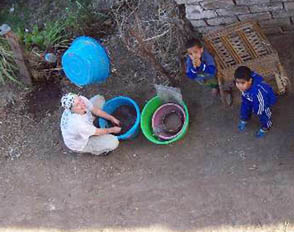 | Left : Claire floating samples with assistants. |
As Claire describes it: All of the botanical samples remaining to be studied were processed by bucket flotation using a 0.5 mm mesh and botanical remains were identified. The majority of the material from all samples is indicative of domestic waste, charred by use as fuel in hearths/ovens.
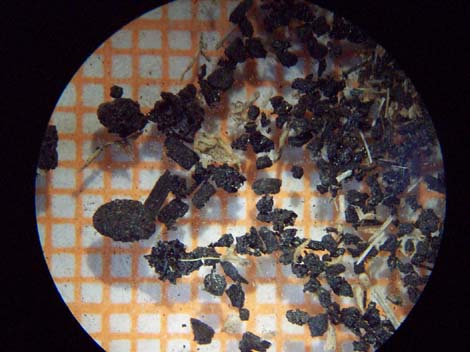
The material from Excavation 1 (Ramesside Period) was in notably poor condition, partly due to the damage caused by the intrusion of modern roots into the features, and by the salts in the ground. This damage may also be due to earlier processes – chewing by animals as fodder (the dung then used as fuel), or by trampling and sweeping of the waste from floors and hearths into waste dumps. Context [1025] provided a rich assembly of material. During excavation this was thought to be a dump associated with an oven feature [1036], and the botanical material supports this hypothesis as the species and plant elements present are typical of domestic fuel; Barley and Emmer wheat chaff, Clover, Rye grass and other crop weed seeds, charcoal (possibly from acacia) and straw.
Context [1094] seems to be the most ‘primary’ deposit, and the least affected by site taphonomy. The sample was considerably richer than any other sample analysed from Excavation 1, most of the floated material was identifiable plant remains, with some heavily damaged unidentifiable fragments and some wood charcoal fragments present, as well as some modern roots. The sample itself was clearly very rich in charred material, even prior to floating as the soil was almost black. In fact, over 2.5% of the entire sample was charred material (most other samples had between 0.74% – 0.01% charred material). Very interestingly the sample contained really very little cereal processing waste, but high counts of both glume Wheat (Triticum dicoccum) and Barley (Hordeum sativum) grains, as well as large numbers of the typical cereal weed-grasses Lolium sp. and Phalaris sp. It also contained the most diverse group of species from Excavation 1, making it hard to define from which process this material might derive. Quite a few of the species present in the sample are indicators of damp and saline soils : sedges – Carex sp., and Scirpus sp. and the Chenopodiace family, especially Suaeda sp, Beta vulgaris tolerates damp saline conditions as well. Many of the species, including those listed above, are weeds of cultivation and, if the cultivation lay alongside canals, then damp salty conditions could be present in parts of the fields. Perhaps this assemblage represents the clearance of particularly weedy, canal or field boundaries.
Seals
Scott Harder worked as our technical support for one season. This meant that he undertook tasks which were essential, but could also be described as tedious. For example, he went through all of our drill core bags, recording and measuring the small pottery fragments recovered from the drill cores. He also assisted Claire in her sorting of the botanical material and made one of the most exciting discoveries of all of our work at Sais.
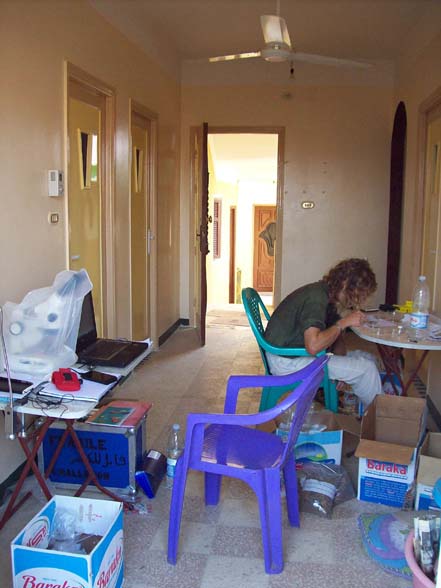
One of the human burials in Excavation 5 had been surrounded by a black mud which clearly contained pieces of pottery and other materials. Around 5 kilograms of this material was collected for analysis which Claire carried out. During the sorting process, Scott noticed that there were pieces of material that were not pottery, but not bone or plant remains. He also noticed that they seemed to have patterns and designs on them. They were, in fact, fragments of mud which had been stamped with seals. Judging from the impressions on the back of the seals, they had once been attached to papyrus documents. The documents must have once arrived at Sais sealed with string and mud and stamped with the individual seal of the sender or administrative office. The seals were broken and documents carried off for archive storage. Unfortunately we no longer have the documents, but the seal fragments had been reused later as fill for the grave of the burial.
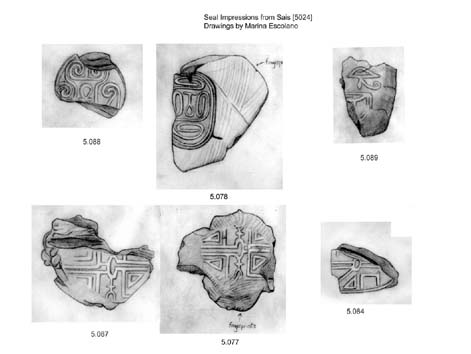
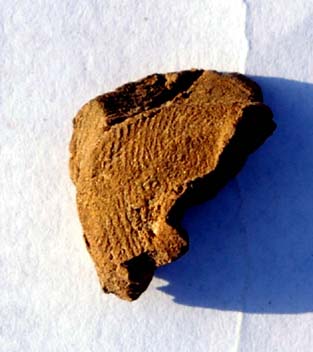 | Left : Fingerprints on the back of a seal. |
| Right : Fine grass or thread marks on the back of a seal. | 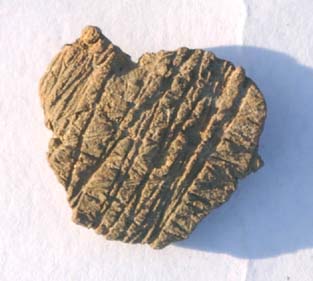 |
The clearest seal impression showed scroll patterns around the outside, with a clear nefer-sign in the centre; there was also a seal with a wedjat-eye on it; and three pieces of a geometrical patterns consisting of diamonds and triangles. In addition the fingerprints of the person who put the mud onto the documents were also clear. We had found such seals before, but not with these details on them and not in this quantity. They can be dated to the end of the Middle Kingdom and perhaps to the 15th-16th dynasty, that is in the Second Intermediate Period. The presence of the seals from papyrus documents suggests that there was either a household receiving letters from elsewhere in Egypt or some kind of administrative centre at Sais at that time. The seal impressions, however, are too generic to allow any further conclusions.
Zooarchaeological study
Louise Bertini has been working on the animal bones from Sais as part of her PhD at Durham University, under the supervision of Drs Wilson and Keith Dobney. For the Sais project, Louise has worked with Salima Ikram of the AUC in identifying the animal species from the bones and also establishing other information such as age at death of the animals, cut marks on the bone showing butchery, or information about seasonal husbandry practices.
The animal bones material from the excavations shows that different species of animals are dominant according to the time periods of the different excavations .
Prehistoric period: mainly fish bones, pig, cattle, hippopotamus, gazelle
Predynastic period: cattle bones, sheep-goat, pig, rodents, birds, donkey
Ramesside Period: cattle, fish, sheep-goat
Third Intermediate Period: cattle, sheep-goat
Saite Period: cattle, sheep-goat, donkey

T
he differences may show the types of meat that was available and farmed in the area and there is a noticeable change from the wilder species of animal such as hippopotamus, gazelles and a broad range of fish species. This suggests that anything could be caught and killed perhaps for food.
All of the material is now being collected and studied ready for inclusion into the various site reports which are planned from the work. The most time consuming task still remaining is the preparation of the inked pottery drawings and small find drawings from the excavations. As pottery was the single most type of find made, and also because the assemblages and groups are the first recorded pottery finds from the site, care was taken to collect as representative a sample as possible. The aim is to create basic typologies for each period investigated, to create a corpus which can be compared at other sites and also in any future work at Sais. At the time of writing this report most of the Excavation 1 pottery is inked, and a small proportion of the small finds; Excavation 8 Prehistoric sherds are inked, some flint and small finds; around half of the Excavation 4 pottery is inked. This still leaves much work to be done, with the Third Intermediate Period giving us some cause for concern.
